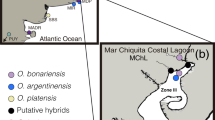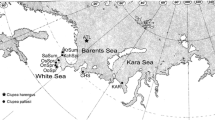Abstract
Hybridization is common among freshwater fishes, particular among the Cyprinidae. We used two mitochondrial genes and one nuclear gene to characterize hybridization among two species pairs of Cyprinella in southwestern North America. Genalogical patterns revealed that C. lutrensis and C. venusta are currently hybridizing in several localities producing apparent F1, F2 and backcross generations, yet there was no evidence for introgression outside of local hybrid zones. Alternatively, mitochondrial haplotypes from C. lutrensis appear to have introgressed into a C. lepida population in the Nueces River completely replacing the native C. lepida haplotype. There was no evidence of introgression of nuclear DNA and there does not appear to be ongoing hybridization. The population of C. lepida from the nearby Frio River exhibits no evidence of hybridization with C. lutrensis. Thus, contact between C. lutrensis and C. venusta results in the formation of localized hybrid swarms, while contact between C. lutrensis and C. lepida has resulted in complete mitochondrial introgression in the Nueces River or no apparent hybridization in the Frio River. The three different outcomes of contact between these species illustrate the variable nature of interspecific reproductive interactions and provide an excellent system in which to better understand the factors influencing hybridization among freshwater fishes.




Similar content being viewed by others
References
Aboim MA, Mavarez J, Bernatchez L, Coelho MM (2010) Introgressive hybridization between two Iberian endemic cyprinid fish: a comparison between two independent hybrid zones. J Evol Biol 23:817–828
Alves MJ, Coelho MM, Collares-Pereira MJ (2001) Evolution in action through hybridization and polyploidy in an Iberian freshwater fish: a genetic review. Genetica 111:375–385
Blum MJ, Walters DM, Burkhead NM, Freeman BJ, Porter BA (2010) Reproductive isolation and the expansion of an invasive hybrid swarm. Biol Invasions 12:2825–2836
Bolnick DI, Near TJ (2005) Tempo of post-zygotic reproductive isolation in sunfishes (Teleostei: Centrarchidae). Evolution 59:1754–1767
Broughton RE and Gold JR (2000) Phylogenetic relationships in the North American cyprinid genus Cyprinella (Actinopterygii: Cyprinidae) based on sequences of the mitochondrial ND2 and ND4L genes. Copeia 1–10
Campton DE (1987) Natural hybridization and introgression in fishes: Methods of detection and genetic interpretations. In: Ryman N, Utter F (eds) Populations genetics and fishery management. University of Washington Press, Seattle, pp 161–192
DeMarais BD, Dowling TE, Douglas M, Minckley WL, Marsh P (1992) Origin of Gila seminuda (Teleostei: Cyprinidae) through introgressive hybridization: Implications for evolution and conservation. Proc Nat Acad Sci USA 89:2747–2751
Dowling TE, Childs MR (1992) Impact of hybridization on a threatened trout of the Southwestern United States. Conserv Biol 6:355–364
Dowling TE, Secor CL (1997) The role of hybridization in the evolutionary diversification of animals. Ann Rev Ecol Syst 28:593–619
Dowling TE, Smith GR, Brown WM (1989) Reproductive isolation between Notropis cornutus and Notropis chrysocephalus (family Cyprinidae): Comparison of morphology, allozymes, and mitochondrial DNA. Evolution 43:620–634
Dowling TE, Broughton RE, DeMarais BD (1997) Significant role for historical effects in the evolution of reproductive isolation: evidence from patterns of introgression between the cyprinid fishes, Luxilus cornutus and Luxilus chrysocephalus. Evolution 51:1574–1583
Echelle AA, Connor PJ (1989) Rapid, geographically extensive genetic introgression after secondary contact between two pupfish species (Cyprinodon, Cyprinodontidae). Evolution 43:717–727
Gerber AS, Tibbets CA, Dowling TE (2001) The role of introgressive hybridization in the evolution of the Gila robusta complex (Teleostei: Cyprinidae). Evolution 55:2028–2039
Harrison RG (1990) Hybrid zones: windows on evolutionary process. Oxf Surv Evol Biol 7:69–128
Hubbs CL (1955) Hybridization between fish species in nature. Syst Zool 4:1–20
Hubbs C (1972) A checklist of Texas freshwater fishes. Tex Parks Wildl Dept Tech Ser 11:1–11
Hubbs C, Strawn K (1956) Interfertility between two sympatric fishes, Notropis lutrensis and Notropis venustus. Evolution 10:341–344
Jordan DS, Evermann BW (1896) The fishes of North and Middle America. Bull US Nat Hist Mus 47:1–1240
Keck BP, Near TJ (2010) Geographic and temporal aspects of mitochondrial replacement in Nothonotus darters (Teleostei: Percidae: Etheostomatinae). Evolution 64:1410–1428
Lytle GL (1972) Cyprinid fishes of the subgenus Cyprinella of Notropis from southeast Texas, USA., and northeast Mexico, M.S. Thesis, Arizona State University, Tempe, AZ
Matthews WJ (1987) Geographic variation in Cyprinella lutrensis (Pisces: Cyprinidae) in the United States, with notes on Cyprinella lepida. Copeia 1987:616–637
Mayden RL (1989) Phylogenetic studies of North American minnows, with emphasis on the genus Cyprinella (Teleostei: Cypriniformes). Univ Kansas Mus Nat Hist Misc Publ 80:1–189
Mayden RL, Burr BM, Page LM, Miller RR (1992) The native freshwater fishes of North America. In: Mayden RL (ed) Systematics historical ecology and North American freshwater fishes. Stanford University Press, Stanford, pp 827–863
Posada D, Crandall KA (1998) Modeltest: testing the model of DNA substitution. Bioinformatics 14:817–818
Richardson LR and Gold JR (1995) Evolution of the Cyprinella-Lutrensis Species-Complex .2. Systematics and Biogeography of the Edwards Plateau Shiner, Cyprinella-Lepida. Copeia 28–37
Ronquist F, Huelsenbeck JP (2003) MrBayes 3: Bayesian phylogenetic inference under mixed models 19:1572–1574
Schmidt TR, Bielawski JP, Gold JR (1998) Molecular phylogenetics and evolutionof the cytochrome b gene in the cyprinid genus Lythrurus (Actinopterygii: Cypriniformes). Copeia 1998:14–22
Schonhuth S, Mayden RL (2010) Phylogenetic relationships in the genus Cyprinella (Actinopterygii: Cyprinidae) based on mitochondrial and nuclear gene sequences. Mol Phylogenet Evol 55:77–98
Scribner KT, Page KS, Bartron ML (2001) Hybridization in freshwater fishes: a review of case studies and cytonuclear methods of biological inference. Rev fish biol fish 10:293–323
Smith GR (1992) Introgression in fishes significance for paleontology, cladistics, and evolutionary rates. Syst Biol 41:41–57
Stamatakis A (2006) RAxML-VI-HPC: Maximum likelihood-based phylogenetic analyses with thousands of taxa and mixed models. Bioinformatics 22:2688–2690
Turner BJ, Brett BH, Miller RR (1980) Interspecific hybridization and the evolutionary origin of a gynogenetic fish, Poecilia formosa. Evolution 34:917–922
Walters DM, Blum MJ, Rashleigh B, Freeman BJ, Porter BA, Burkhead NM (2008) Red shiner invasion and hybridization with blacktail shiner in the upper Coosa River, USA. Biol Invas 10:1229–1242
Acknowledgments
R.E.B. wishes to thank Richard G. Harrison for excellent advice and inspiration. We thank E. Marsh-Matthews, W. Matthews and P. Reneau for assistance collecting or providing specimens. All specimens were collected under the relevant permits granted by the states of Texas and Oklahoma. We thank E. Marsh-Matthews, W. Matthews, J. Gold and L. Richardson for insightful discussions about southwestern Cyprinella. The work benefited from Undergraduate Research Opportunity awards from the University of Oklahoma Honors College (to K.C.V. and L.L.R.) and award DEB-0732988 from the National Science Foundation (to R.E.B.).
Author information
Authors and Affiliations
Corresponding author
Rights and permissions
About this article
Cite this article
Broughton, R.E., Vedala, K.C., Crowl, T.M. et al. Current and historical hybridization with differential introgression among three species of cyprinid fishes (genus Cyprinella). Genetica 139, 699–707 (2011). https://doi.org/10.1007/s10709-011-9578-9
Received:
Accepted:
Published:
Issue Date:
DOI: https://doi.org/10.1007/s10709-011-9578-9




